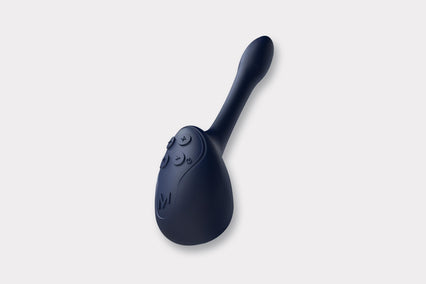Sexual health is something we all care about, yet many of us lack a basic understanding of how our bodies - and our relationships - actually work. Most of what we know comes from whispers and word-of-mouth, but this game of telephone can quickly turn facts into myths and misconceptions. Ready to have your mind blown (outside of the bedroom)? Here are 13 eye-opening sexual health statistics that might surprise you.
1. Happy married couples have sex at least once a week
According to a 2015 study, happily married couples have sex at least once a week. Couples who have sex two, three, or more times a week also have high levels of happiness within their marriage. However, what might surprise you is that the research found more doesn’t always mean better. The sexual satisfaction of couples having sex multiple times a week versus once a week was relatively the same. If that fact has you wondering how often couples should have sex, the answer depends on many factors, but science argues that at least once a week is a good start.
2. People are having less sex than previous generations
According to a 2017 study, married couples and singles in the 1990s had sex an average of 63 times per year - a little more than once a week. People in the 2010s had just 54 sexual encounters a year. In an age where sexuality has become increasingly commonly discussed, it's an interesting paradox that the rate of frequency of sexual encounters appears to be declining.
While there isn’t a way to know for sure what’s causing this (there are likely multiple causes), the authors of the study proposed: “The decline in sexual frequency thus appears to be rooted in twin trends: Americans with steady partners are both fewer in number and have sex less often.”
3. Age isn't slowing intimacy down
According to the University of Michigan’s 2018 National Poll on Healthy Aging, more than 40% of older Americans - those in the 65-80 range - still report having regular sex. Of those who were in long-term relationships, sexual activity increased to 54% of older Americans. A review of published literature on the sex lives of older adults also found that both men and women remained sexually active into their 70s and 80s.
However, this 2008 study mentioned an important factor that greatly impacts the desire and satisfaction of sex - sexual issues such as erectile dysfunction (ED), vaginal dryness, and pain during sex. While these are normal issues due to age, they don’t need to stop your sex life if you have tools like Tenuto 2, which is clinically proven to improve ED by 2x, and Crescendo 2, which is clinically proven to improve painful sex, arousal, and lubrication in women.
4. Women have an average of 4 sexual partners in their lifetimes; men report an average of 7.
Gentlemen never kiss and tell, or do they? According to a CDC survey taken between 2015-2019 of men and women ages 25-49:
- Women had an average of 4 sexual partners
- Men had an average of 6 sexual partners
It's not unusual for people to have multiple sexual partners throughout their lifetime, likewise, it’s also perfectly normal and acceptable to have only one sexual partner in your lifetime if you are lucky enough to find your penguin. Keep in mind, however, that these numbers are self-reported and there’s no sure way to know the real numbers.
5. Only half of women report reaching orgasm during sex
According to a 2016 study in the Archives of Sexual Behavior that looked at over 52,000 adults in the U.S:
- 65% of heterosexual women reported experiencing orgasms during sex
- Conversely, 95% of heterosexual men reported they usually or always orgasm during sex
This discrepancy is called the orgasm gap or the pleasure gap. There are a few ways to close the orgasm gap, such as more foreplay and oral sex for women. If you or your partner is struggling to orgasm during penetrative sex, try the couple’s vibrator Tenuto 2. This wearable male vibrator is a couple’s favorite for a reason - it gives him harder, longer-lasting erections while arousing her clitoris at the same time for mutually pleasurable intimate encounters.
6. 1 in 4 men under 40 experience ED
If you thought ED was an old man’s issue, think again. A 2013 study found that 26% of ED cases come from men under the age of 40. There are many causes of ED, however, it's not always a physical problem. Nearly 40% of ED cases are psychogenic, meaning the cause of ED is psychological or situational. Young men are struggling more often with performance anxiety, which can look like worrying about sexual performance or fretting over pleasuring their partners. There are many strategies for overcoming performance anxiety, such as using Tenuto 2, a male vibrator that’s clinically proven to improve performance anxiety and ED. The best part? It also increases partner pleasure - all hands-free, too.
7. 60% of men masturbated within the past month.
According to a 2010 report on the sexual behavior of Americans, over 60% of men reported masturbating within the past month. Masturbation is an excellent way to relieve tension and promote sexual health. Meanwhile, only around 37% of women reported masturbating within the past month. For some women, a product like Crescendo 2 can help make masturbation exciting and more enticing as it can arouse multiple pleasure zones at the same time, increasing sensation, arousal, and responsiveness for bigger, blended orgasms that can help women match their counterparts’ 60%.
8. 52% of women and 44% of men used vibrators
Vibrators have become a common staple in people’s bedrooms. So, it should be no surprise that a 2009 study found that 52% of women ages 18 to 60 in the U.S. used vibrators. And that’s not all - if you thought vibrators were only for women, guess again - a 2009 study found that:
- 44% of heterosexual men reported having used a vibrator at some point in their lives.
- Among these men, 94% had used a vibrator as part of foreplay with their partner.
- 82% had used a vibrator during intercourse with a partner
Male vibrators can introduce novel pleasure and enhanced sensations to male erogenous zones like the penis and prostate. Before you knock the idea, give vibrators a try, and you might be pleasantly surprised to find your new favorite pastime.
9. Couples who use vibrators communicate more.
A 2020 study found a strong correlation between vibrator use and better communication both inside and outside the bedroom. Couples who use vibrators were able to communicate better about what they like and dislike in the bedroom. If you thought couple's vibrators only enhanced pleasure, consider how they can also improve communication, too.
10. 67% of people feel that emotional connection results in the best sex.
If you're struggling to feel connected in the bedroom, odds are that you aren't feeling connected to your partner outside of the bedroom. That’s because great sex isn’t just about orgasm, but about emotional connection too. In a 2023 study, 67% of people said that emotional connection was the most important factor that contributed to great sex. If you're feeling disconnected in bed, consider exploring ways to improve your intimacy, such as scheduling date nights, taking baths together, or cuddling and watching your favorite film together.
11. Ejaculation can reduce the risk of prostate cancer
Now that’s a bold statement, but according to a 2004 study, a correlation was found between ejaculation frequency and prostate cancer risk. 21 is the magic number. Men who ejaculated 21 times per month, as compared to those who ejaculated 4-7 times per month, had a significantly lower risk of developing prostate cancer. More research is necessary, but one plausible theory might be that ejaculation helps release the buildup of prostatic fluid that can cause blockages, pressure, or inflammation. Prostate inflammation or prostatitis is no laughing matter, so if this is a concern, and you’re seeking more prevention methods, check out the urologist-designed prostate vibrator Molto, which is clinically proven to improve prostatitis symptoms by 57%.
12. During orgasm, your brain resembles a brain on heroin
We’re not saying sex is a drug, but it might feel that way. Studies have found that during orgasm, your brain releases a rush of natural feel-good chemicals, activating regions of the brain deeply involved in pleasure, reward, and memory. Interestingly, these same brain regions become active when someone uses opioids like heroin. While this doesn't mean orgasms are harmful or addictive like drugs, it highlights how intensely pleasurable orgasms naturally are, giving you one of the strongest natural highs your brain can experience.
13. The clitoris has over 10,000 nerve endings – twice as many as a penis
The clitoris has over 10,000 nerve endings, twice as many as a penis, and way more than anyone thought. Scientists used to think the clitoris had around 8,000 nerve endings, but 2022 research found it actually has over 10,000. Researchers studied nerve samples from people who were having gender-affirming surgeries. That makes the clitoris one of the most sensitive parts of the body, designed specifically for pleasure. Understanding this sensitivity can help people learn more about their own bodies and have even better sexual experiences.
Takeaway
These sexual health statistics might be surprising, but they reveal something important: when it comes to sexual wellness, there's always more to learn. Understanding your body and your partner's desires can help you graduate to greater intimacy, pleasure, and connection.
Now it’s your turn to create your own mind-blowing sexual health stats. With the help of award-winning vibrators clinically proven to enhance arousal and performance, you and your partner can explore every nerve ending of the clitoris, move past anxiety into primetime performance, and discover even more fun facts firsthand.















































